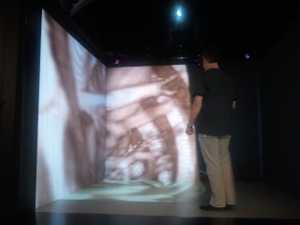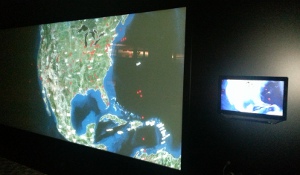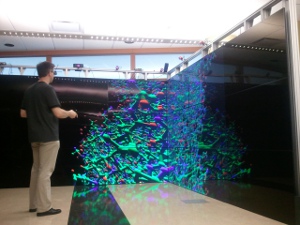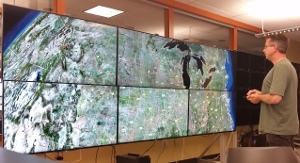Home
Recent
2022.01.03 Our new CAVE-type display, an ActiveCube by Virtalis, is now fully installed and working in the Appenzeller Visualization Laboratory
Appenzeller Visualization Laboratory
The Appenzeller Visualization laboratory is housed in Joshi 278 and provides access to cutting edge visualization technology and equipment, including a traditional CAVE-type setup as well as other fully immersive display environments.
The new ActiveCube installed by Virtalis is now available. It provides
access to a CAVE-type display system with three walls plus the floor
and resolutions of up to 2500x2500 per screen combined with active-stereo
glasses and high-resolution optical tracking.

Barco's I-space delivers visualization capabilities similar to a traditional CAVE-type configurations with four walls covering a 10 by 10 feet footprint. Active stereo glasses and optical tracking ensures a fully immersive experience P17,P18,P29.

A rear-projection display provides a large projection surface for discussing various types of data sets. Different input modalities, including touch, allow for intuitive interaction with easy access.

Tiled display systems can provide similar capabilities compared to traditional CAVE-type displays. The fully in-house developed, custom-built DIVE (Display Infrastructure for Virtual Environments) configuration provides three walls with a 12 by 12 feet walkable footprint. The walls each consist of a 3 by 3 configuration of stereo-capable 55-inch full-HD, LED-backlit displays with only 3mm bezels. The system is driven by a traditional computer setup with one master node and three slaves driving the surrounding walls. Natural Points's Optitrack is used for optical tracking to ensure fully immersive capabilities P17,P18,P20,P29,J20.

In order to achieve display capabilites with higher resolution, a tiled display configuration is available consisting of 20 full-HD-capable monitors in a 5 by 4 setup driven by a single computer.

One of the disadvantage of tiled displays are typically the bezels of the individual screens creating a discontinuity within the image. By using slim bezel screens this effect can be reduced. Further, the use of higher resolution screens, in this case 4K, combined with larger sized screens can achieve even higher resolutions overall for the tiled display but with a significant reduction in distracting bezel area. This resulted in a 3 by 2 configuration of 4K screens yielding an overall resolution of 48 megapixels. The additional touch capabilities further enhance the user interface P29.

A mobile solution is provided by a rear-projected display system that utilizes a combination of two standard projectors with full-HD resolution. Stereoscopic capabilities are achieved with passive polarization filters and glasses combined with Kinect-based head-tracking for a low-cost solution P17,P18,P29.

Head-mounted displays can povide a full 360-degree view as small displays with appropriate lenses mounted in front of them are placed directly in front of the user's eyes. The Appenzeller Visualization laboratory provides access to Sony's HMZ-T1, the Oculus Rift, HTC Vive, and HP's Mixed Reality headset. Combined with optical tracking or the built-in rotational tracking of the Oculus Rift a fully immersive environment can be created P29.


Similar to the teaching laboratory, the displays available in the Appenzeller Visualization laboratory utilize the Vrui library to drive the displays. This allows for maximal compitability between all display systems available in the research and teaching laboratories. The configurations are specifically customized to support all functionalities of each display ranging from input devices, such as game controllers or touch-based input, to tracking. Some of these configurations are custom-built specifically for the environment available, for example, touch-based input providing tablet-based input paradigms, such as pinch-zoom. Since the software environment is virtually identical to the teaching laboratory, the usage instructions apply just the same.
You can check availibility of the lab here. The lab may also be contacted directly via (331) 642-8432. However, for scheduling the lab or other inquiries please contact the lab director Thomas Wischgoll.
